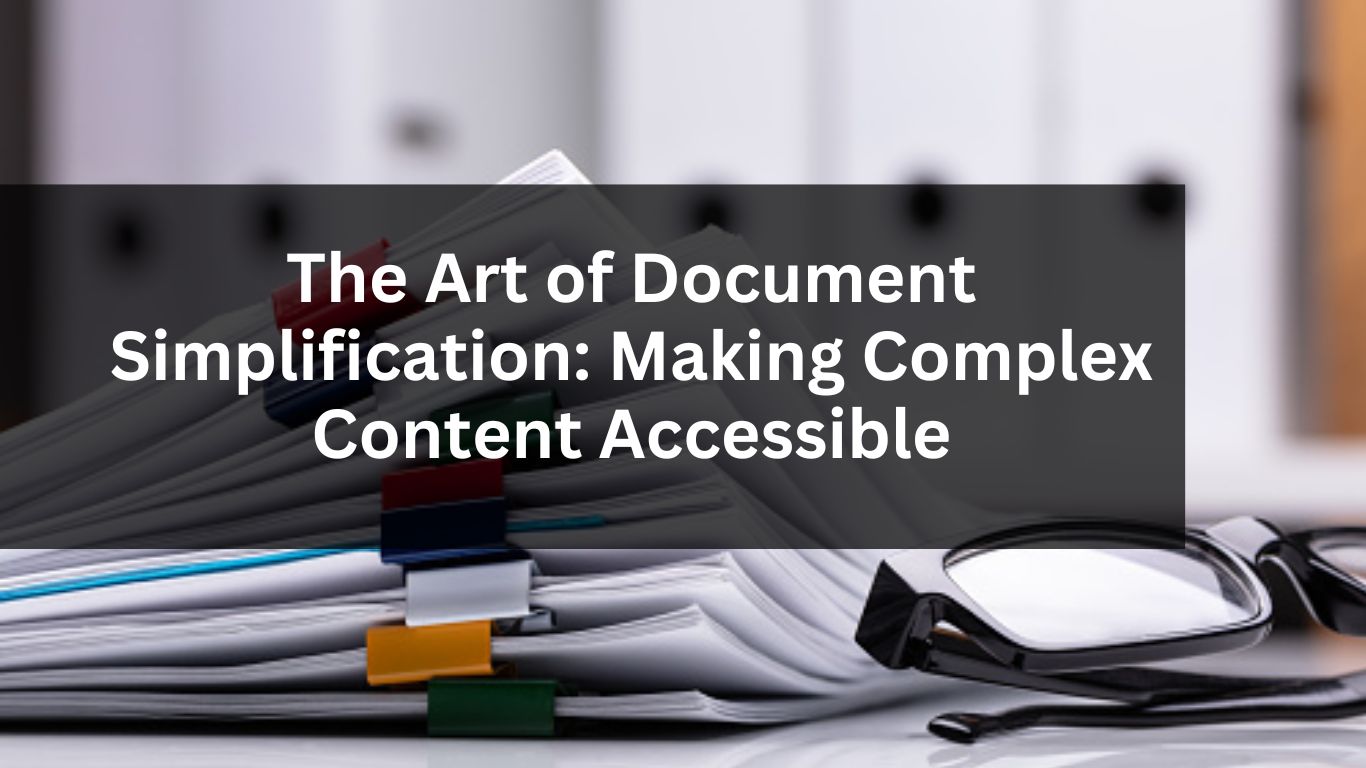Unlocking Knowledge Through Document Simplification:
In today’s fast-paced and information-rich world, the sheer volume of complex documents can feel overwhelming. From legal contracts and technical manuals to academic papers, these materials are often written in specialized jargon that makes them inaccessible to the average reader. This is where document simplification becomes invaluable. By transforming intricate content into clear, understandable formats,
Quadrate ensures vital information is accessible to everyone, regardless of their background or expertise.
What is Document Simplification?
 Document simplification is the process of converting complex, dense, or technical texts into more reader-friendly formats. This involves analyzing the original content, identifying key points, and rephrasing the material in straightforward, concise language. The ultimate aim is to make the document comprehensible for a broader audience without compromising the accuracy or essence of the original information.
Document simplification is the process of converting complex, dense, or technical texts into more reader-friendly formats. This involves analyzing the original content, identifying key points, and rephrasing the material in straightforward, concise language. The ultimate aim is to make the document comprehensible for a broader audience without compromising the accuracy or essence of the original information.
At Quadrate, we specialize in simplifying content across industries, ensuring clarity and precision for legal, technical, medical, and business documents.
The Importance of Document Simplification:
1.Improved Comprehension
Simplified documents allow readers to better understand and retain the information presented. This is particularly vital in industries like healthcare or law, where comprehension can directly impact decisions and outcomes.
2.Increased Accessibility
By breaking down technical jargon and complex language, simplified documents reach a wider audience. Whether it’s individuals with different educational backgrounds, non-native speakers, or those with cognitive challenges, simplified texts foster inclusivity.
3.Enhanced Communication
Clear communication is the backbone of effective decision-making. In fields like education, legal services, and healthcare, misunderstandings due to complex wording can lead to costly or even life-altering errors.
4.Time Efficiency
Simplified documents save time. Readers can quickly grasp essential points without wading through unnecessary details or confusing structures, leading to greater productivity.
At Quadrate, our focus is on delivering clarity and precision, ensuring every word we simplify resonates with its intended audience.
The Process of Document Simplification
Simplifying a document involves more than just rephrasing words. It’s a multi-step process designed to retain the integrity of the original information while making it easier to understand.
1. Content Analysis
The first step is a detailed review of the original text. We identify the key concepts, technical terms, and any sections that could be simplified. This analysis ensures the core message remains intact while pinpointing areas for improvement.
2. Restructuring for Clarity
Complex content often lacks logical flow, making it difficult to follow. Restructuring the document involves reorganizing the text into a coherent and logical progression. For example, headings and subheadings may be added to create a clear structure.
3. Rephrasing and Simplification
Long-winded sentences, jargon, and technical language are simplified into concise, commonly understood terms. At Quadrate, we prioritize the use of plain language, ensuring the document is relatable while preserving its original intent.
4. Incorporating Visual Aids
Visual aids such as diagrams, charts, and illustrations are powerful tools for conveying complex ideas. They break up dense text and provide readers with additional clarity, enhancing the overall comprehension of the material.
5. Formatting and Layout
Good design matters. Proper formatting with clear headings, bullet points, and adequate spacing improves readability. A well-organized layout helps readers quickly navigate and absorb the content.
Why Choose Quadrate for Document Simplification?
At Quadrate, we understand the challenges of deciphering complex documents. Our team of experienced professionals combines expertise in language, industry-specific knowledge, and attention to detail to deliver simplified content that speaks to your audience.
Whether you’re working on legal agreements, technical manuals, or educational materials, we ensure that the final output is accurate, accessible, and impactful. With our SEO-focused approach, we also optimize content for digital platforms, increasing its reach and engagement.
Maintaining the Balance: Simplification Without Compromise
 While simplifying documents, it’s critical to avoid oversimplification that could distort the original meaning. At Quadrate, we take a balanced approach:
While simplifying documents, it’s critical to avoid oversimplification that could distort the original meaning. At Quadrate, we take a balanced approach:
- Retaining the integrity of the core information.
- Ensuring industry-specific terminology is accurately represented.
- Avoiding unnecessary reductions that compromise the document’s intent.
This meticulous attention to detail makes our services reliable for professionals across sectors.
Benefits of Simplified Documents
By transforming complex information into accessible formats, document simplification empowers individuals to:
- Make informed decisions by understanding contracts, manuals, and guidelines.
- Participate in discussions with confidence, equipped with comprehensible information.
- Access opportunities that were previously inaccessible due to language or complexity barriers.
Conclusion
In an era where clarity and accessibility are paramount, document simplification is no longer optional—it’s a necessity. Quadrate is committed to bridging the gap between specialized knowledge and general understanding.
By simplifying complex documents, we empower individuals and organizations to communicate effectively, save time, and foster inclusivity.
Whether you’re a business looking to enhance customer engagement or an individual seeking clarity in legal or technical texts, Quadrate is your trusted partner in document simplification. Let us help you transform complexity into clarity today.

